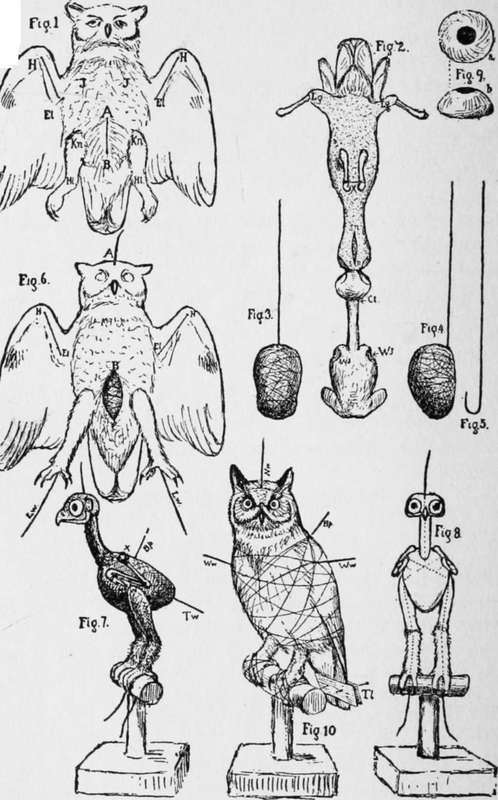Stuffing An Animal
Description
This section is from the book "The Book Of Woodcraft", by Ernest Thompson Seton. Also available from Amazon: The Book of Woodcraft.
Stuffing An Animal
Mounting a mammal, popularly called animal, is a much more difficult thing than mounting - that is, stuffing - a bird.
To illustrate the mounting of a Horned Owl.
It is so difficult that I do not advise any boy to try it unless he has the time and patience to go into it seriously. To do this he should get some standard treatise on Taxidermy, such as:
"Taxidermy and Zoological Collecting," by W. T. Hornaday. (Scribners. $2.50) or "The Art of Taxidermy," by John T. Rowley. (Mac-millan's. $1.75).
Nevertheless all may learn to preserve the skins of small animals for cabinet collections, or for mounting at some later time.
The best instructions for this are those issued by the Biological Survey of the United States Department of Agriculture. I reproduce them.

Preserving Small Mammal Skins By Dr. C. Hart Merriam
Directions For Measurement
The tools necessary for measuring mammals are a pair of compasses or dividers, a steel rule graduated in millimeters, and two large pins. Dividers with round points are better than those with triangular points.
All measurements should give the distance in a straight line between the points indicated. They should be taken by means of dividers, or by driving pins into a board to mark the points between which the measurement is desired. They should never be made with a tape-line over the convexities or inequalities of the surface.
The three most important measurements, and those which should always be taken in the flesh are: (1) total length; (2) length of tail; (3) length of hind foot.

(1) The total length is the distance between the tip of the nose and the end of the tail vertebrae. It is taken by laying the animal on a board, with its nose against a pin or upright post, and by straightening the back and tail by extending the hind legs with one hand while holding the head with the other; a pin is then driven into the board at the end of the vertebrae. (See Fig. 2).
(2) The length of tail is the length of the caudal vertebrae. It is taken by erecting the tail at right angle to the back, and placing one point of the dividers on the backbone at the very root of the tail, the other at the tip end of the vertebrae. (See Fig. 3).
(3) The hind foot is measured by placing one point of the dividers against the end of the heel (calcaneum), the other at the tip of the longest claw, the foot being flattened for this purpose. (See Fig. 4).
Directions For The Preparation Of Skins
Skin all mammals as soon as possible after death.
Lay the animal on its back, and make an incision along the middle of the belly from just behind the fore legs nearly to the vent. Be careful not to stretch the skin while removing it, and exercise great caution in skinning around the eyes and lips, which are easily cut. Skin as far down on the feet as possible, but leave in the bones of the legs. Remove the bone from the tail by pulling it between the fingers (in the larger species a split stick answers well). Take out the skull, being careful not to cut or injure it in any way, and wash out the brains by means of a syringe or jet of water. Remove the tongue, and cut off the thick flesh from the sides and base of the skull. Tie a tag to the skull, bearing the same number that is attached to the skin, and dry in the shade. In damp weather it is sometimes necessary to use powdered borax to prevent the remaining flesh from decomposing. Never put arsenic or salt on a skull.
Remove all fat and tags of flesh that adhere to the skin. In cleaning off blood or dirt that may have soiled the hair an old toothbrush and a liberal supply of corn-meal will be found serviceable.
Poison all parts of the skin with dry arsenic (or better still, with a mixture of powdered arsenic and alum in the proportion of four parts arsenic to one part alum), being particular to put an extra supply in the feet and tail. Put a wire in the body, letting it extend to the extreme tip of the tail, but be careful not to stretch the tail. Use annealed iron wire of as large size as will fit easily into the tip end of the tail. In rabbits, foxes, and wildcats put wires in the legs also.
Stuff the skin to nearly its natural size with cotton or tow (never use wool, feathers, or other animal substances); sew it up along the belly, and place it flat on a board to dry (belly down), with the fore legs extended in front and parallel to the body (i. e., not projecting sideways), and the hind legs and tail directed backward. The accompanying cut (Fig. 1) shows the appearance of a well-made skin.
Attach to each skin a label bearing the same number that is given the skull. On this label should be stated the sex, locality, date of capture (name of month should always be written in full), and name of collector.
All skins should be thoroughly dry before they are packed for shipment. They should be carefully wrapped in cotton and packed in small wooden boxes. Cigar-boxes do very well for the smaller species.
Washington, D. C, March, 1889.
Continue to:
Tags
bookdome.com, books, online, free, old, antique, new, read, browse, download
